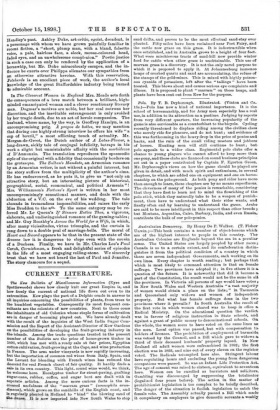CURRENT LITERATURE.
The Seto Bulletin of Miscellaneous Information (Eyre and Spottiswoode) shows how closely knit our great Empire is, and how freely the current of national life flows out even to its extremities. Kew plays the part of a Delphic oracle in answer to all inquiries concerning the possibilities of plants, from trees to the humblest vegetables. Consequently its most frequent con- sultants are the colonists of new countries. Next to these come the inhabitants of old Colonies whose staple forms of cultivation are in danger of becoming played out. We have already dealt with the result of the inquiries of the West India Sugar Com- mission and the Report of the Assistant-Director of Kew Gardens on the possibilities of developing the fruit-growing industry in the islands. Among the trade questions treated in the present number of the Bulletin are the price of home-grown timber in 1896, which has met with a ready sale at fair prices, Egyptian cotton cultivation, fruit-growing at the Cape, and wine production in France. The area under vineyards is now rapidly increasing, but the importation of common red wines from Italy, Spain, and the Levant for blending with French wines has reduced the demand for real French claret of fair quality. It hardly finds a sale in its own country. This light, sound wine would, we think, be welcome here. Eucalyptus timber for street-paving, grafting sugar-cane, rubber, coffee, and sugar beet are dealt with in separate articles. Among the more curious facts is the in- creased usefulness of the " marram grass" (ammophila arun- dinexea), which grows on the sandhills of the English coast, and is regularly planted in Holland to "bind" the blowing sand of the dunes. It is now imported into New South Wales to stop
sand drifts, and proves to be the most effectual sand-stay ever planted. Fifty miles have been reclaimed near Port Fairy, and the cattle now graze on this grass. It is indestructible when once established, and in Australia grows to a height of four feet. What were mischievous tracts of sand-hill now provide winter food for cattle when other grass is unobtainable. This use of marram grass is a discovery. It is not the only novel purpose to which it is proposed to apply it. At Johannesburg immense heaps of crushed quartz and sand are accumulating, the refuse of the stamps of the gold-mines. This is mixed with highly poison- ous cyanide of potassium, left after the " tailings " have been treated. This blows about and causes serious eye complaints and illness. It is proposed to plant " marram" on these heaps, and plants have been sent out from Kew for the purpose.






































 Previous page
Previous page